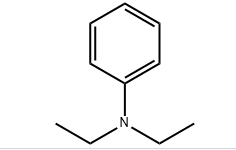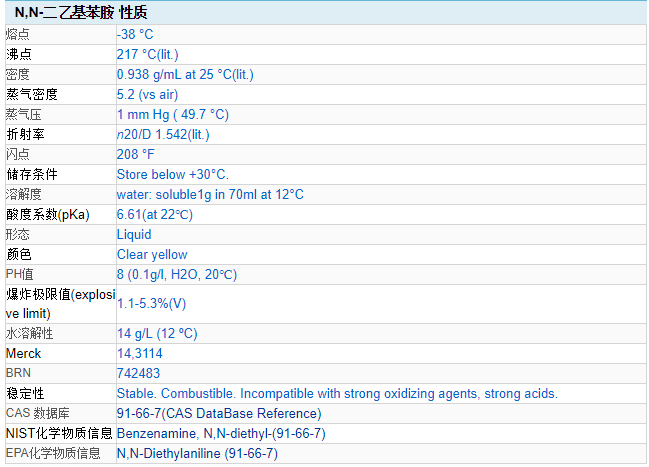Synonyms:
N,N-DIETHYLANILINE,98%N,N-DIETHYLANILINE,98%N,N-DIETHYLANILINE,98%;N,N-DiethylbenzeneaMine;Phenyldiethylamine;Pregna-1,4-diene-3,20-dione,17 ,21-bis(acetylChemicalbookoxy)-2-bromo-6,9-difluoro-11-hydroxy-,(6b,11b)-;coMpoundwithborane;N,N-Diethylaniline,99%250ML;N,N-Diethylaniline,99% 5ML;N,N-Diethylanilinepuriss.pa,>=99.5%
CAS Number: 91-66-7
Molecular formula: C10H15N
Molecular weight: 149.23
EINECS number: 202-088-8
Related categories:
aromatic hydrocarbons; organic raw materials; pharmaceutical raw materials; amines; industrial raw materials; general reagents; dye intermediates; pharmaceutical intermediates; organic building blocks; Intermediates of Dyes and Pigments; Organics; organic chemical Chemicalbook; Amines; Building Blocks; C10; Chemical Synthesis; Nitrogen Compounds; Organic Building Blocks; Intermediate Body; organic chemical raw materials; chemical raw materials; amines


N,N-Diethylaniline Usage and Synthesis
Chemical properties:
Colorless to yellow liquid. Has a special smell. Slightly soluble in water, soluble in organic solvents such as ethanol, ether, chloroform and benzene.
Purpose:
1. Used in dye intermediates, latex accelerators, pharmaceuticals, pesticides, etc.
2. Diethylaniline is mainly used in the production of azo dyes and triphenylmethane dyes. It can be used to prepare basic brilliant green, basic violet, acid lake blue V, etc.; it is also an intermediate in the pharmaceutical industry and color film developer. Used as analytical reagent and detection of zinc and manganese.
3. Used as an analytical reagent and also used in organic synthesis
Production method:
It is obtained from the reaction of aniline and ethyl chloride. Raw material consumption quota: 645kg/t of aniline, 1473kg/t of ethyl chloride (95%), 1230kg/t of caustic soda (42%), 29kg/t of phthalic anhydride.
Category: Toxic
Toxicity classification: high toxicity
Acute toxicity: Inhalation: rat LC50: 1920 mg/m3/4 hours; intraperitoneal injection-rat LD50: 420 mg/kg
Flammability and hazard characteristics:
Open flames are combustible; react with oxidants; burn to produce toxic nitrogen oxide fumes
Storage and transportation characteristics:
The warehouse is ventilated, low temperature and dry; stored separately from acids, oxidants, and food additives
Extinguishing agent: foam, carbon dioxide, sand
Upstream source: ethanol–>aniline
Downstream products: Xanthoxylin alcohol–>4,6-diamino-5-nitropyrimidine–>2-amino-4,6-dichloro-5-carboxamidopyrimidine–>2-chloro-4- Dimethylamino-5-bromopyrimidine–>4,5′,8-trimethyl]psoralen–>2,4-dichloro-5-cyanopyrimidine–>2,4-amino Pyrimidine-5-carboxylic acid–>2-bromofuran–>2,4,6-trichloropyrimidine-5-amine–>2-chloro-4-amino-5-nitropyrimidine–>4, 6-Dichloro-1ChemicalbookH-pyrazolo[3,4-C]pyrimidine–>Davisin-7-methyl ether–>5-nitro-2,4,6-trichloropyrimidine–>2, 4-Dichloro-5-nitro-6-methylpyrimidine–>2-methoxy-4-amino-5-nitropyrimidine–>2-chloro-4-bromopyrimidine–>2-chloro -4,5-Diaminopyrimidine–>2,4-Dichloro-5nitropyrimidine–>Scopoletin–>p-aminodiethylaniline sulfate–>N,N-diethyl P-Phenylenediamine Hydrochloride–>Phenylbis-(p-diethylaminobenzene)methane
Post time: Apr-22-2021





